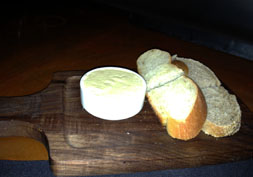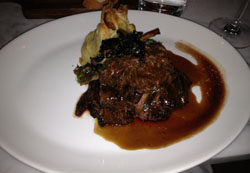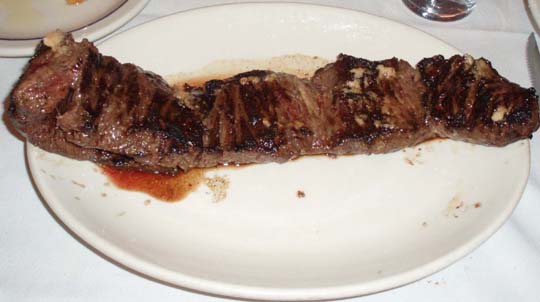Jezebel
 Monday, February 4, 2013 at 08:36PM
Monday, February 4, 2013 at 08:36PM Note: After I wrote this post, the restaurant’s owner wrote a couple of nasty tweets about my reviewing qualifications. Turns out, I wasn’t so far off. About a month after our visit, the restaurant hired a new chef, Chris Mitchell, and changed its kosher supervision to the Orthodox Union, in order to broaden its appeal among kosher diners. The OU insisted that the restaurant change its name to “The J Soho,” since Jezebel (as noted below) is “a clearly wicked person” in the Bible. That strategy didn’t work. The J Soho closed in late 2013.
*
 Do you remember the TV series Chicken Soup, a 1989 sitcom that starred Jackie Mason in an improbable interfaith relationship with Lynne Redgrave? It was canceled after eight episodes.
Do you remember the TV series Chicken Soup, a 1989 sitcom that starred Jackie Mason in an improbable interfaith relationship with Lynne Redgrave? It was canceled after eight episodes.
If you apply the same idea to restaurants, you wind up with Jezebel, an expensive Glatt Kosher restaurant in Soho that looks like it was helicoptered in from the Meatpacking District.
 In the Book of Kings, Jezebel is a Phoenician princess who was murdered by being thown out a window. She is also sometimes associated with false prophets and prostitution. Why they chose this name for the restaurant is beyond me. Perhaps there is a Talmudic connection I have missed.
In the Book of Kings, Jezebel is a Phoenician princess who was murdered by being thown out a window. She is also sometimes associated with false prophets and prostitution. Why they chose this name for the restaurant is beyond me. Perhaps there is a Talmudic connection I have missed.
Jezebel has a very clubby look. If I learned that the folks behind Lavo and Tao consulted on the design—to the best of my knowledge, they didn’t—I wouldn’t be the least bit surprised. It occupies a bi-level century-old townhouse, with a plush lounge on the ground floor and a beautifully-appointed 100-seat dining room upstairs. It’s provocatively decorated with a Last Supper parody painting, with Woody Allen in the center chair. A loud Latin sound track seems out of place.
 The host, hostess, and cocktail waitresses are all quite attractive. Cocktails are $16 apiece, and many entrées soar above the $40 mark, but they won’t transfer your tab. The staff hurry you to leave the bar and head for your table, even though neither space is full.
The host, hostess, and cocktail waitresses are all quite attractive. Cocktails are $16 apiece, and many entrées soar above the $40 mark, but they won’t transfer your tab. The staff hurry you to leave the bar and head for your table, even though neither space is full.
Jezebel was packed and exclusive for about three months, but it’s now on OpenTable and bookable most evenings, any time you want. (They’re closed Fridays, of course.) I can’t compare Jezebel to other kosher restaurants, but as a glam restaurant that just happens to keep kosher, Jezebel has very little appeal.
The website credits Bradford Thompson, the former Lever House chef, though the extent of his day-to-day involvement is unclear. The website also claims “extraordinary” and “innovative” cuisine. It is neither. Most of the dishes, in fact, are snoozers. Almost all are very expensive. A $110 steak for two headlined the menu, with no mention of quality or aging, whcih probably means it was unaged choice. (Do the laws of Kashrut even allow aging?)
I didn’t photograph the bread course, but there was hardly any need: unimpressive onion rolls. The Daily News review mentioned a carrot-and-chickpea spread that’s supposed to come with it, but our server seems to have forgotten it, and we didn’t know to ask.
An order of veal meatballs (above right) was priced in the high teens. You’ll eat them and quickly forget them. Another restaurant would put cream in the sauce, but Jezebel can’t.


Much the same is true of Salmon (above left) and Braised Short Ribs (above right): just fine, but you’ve had better, for less money. The short ribs, I believe, were $46.
In a new restaurant, I usually ask a server what he recommends. This one went straight to the most expensive item, that $110 steak, strictly an amateur-hour move. He also pushed the side dishes, which we skipped, as they would have been entirely unnecessary. All the other staff were friendly and helpful.
The wine list is better than the restaurant deserves. Some of the prices are just crazy, but there are good bottles under $60, like the 2007 Rioja we had. The rebbe who poured it was a real mensch, one of the highlights of the evening. There’s a cohort of Israeli wines, as you’d expect, but at the prices they’re asking I wasn’t about to risk trying one.
If your beliefs do not require you to eat this way, you’ll find this food very boring. There was, to be fair, nothing specifically wrong with it, except that, for what it is, it ought to cost a lot less.
Food: Boring and very expensive kosher steak and fish
Service: Uneven
Ambiance: Reminds you of a restaurant connected to a nightclub
Rating: Not recommended, except for affluent machers.
 Jezebel in
Jezebel in  Cuisines: Jewish,
Cuisines: Jewish,  Manhattan: SoHo,
Manhattan: SoHo,  Restaurant Reviews
Restaurant Reviews 
























